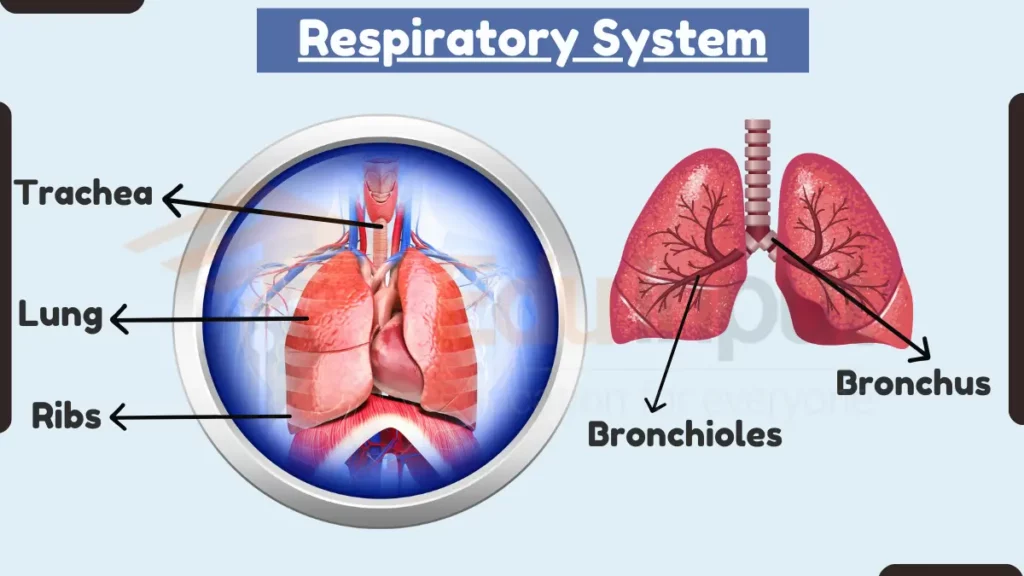Respiratory System – Anatomy, Types, and Functions
The respiratory system is a complex network of organs and structures that allows us to breathe and exchange oxygen and carbon dioxide between the body and the environment.

Also read: How Does the Respiratory System Maintain Homeostasis?
Anatomy of the Respiratory System
The respiratory system can be divided into two main parts:
1. Upper Respiratory Tract
The upper respiratory tract includes different respiratory structures like nose, mouth, pharynx (throat), and larynx (voice box). It is responsible for filtering, warming, and humidifying incoming air, as well as producing sound.
- Nose – Nose is the primary entry point for air. It contains hairs and mucus that trap dust, pollen, and other particles. The nose also helps to warm and humidify the air.
- Mouth – Mouth is another entry point for air, but it is also used for eating and speaking. The mouth contains the tongue, which helps to direct food and air.
- Pharynx – Pharynx is a tube-like structure that connects the nose and mouth to the larynx and esophagus. It plays a role in directing air and food to their respective pathways.
- Larynx – Larynx is also known as the voice box. It contains the vocal cords, which vibrate when air passes over them to produce sound.
Also Read: What is Anatomy?
2. Lower Respiratory Trachea
The lower respiratory tract includes the trachea (windpipe), bronchi, and lungs. It is responsible for transporting air to and from the lungs, where gas exchange occurs.
- Trachea – Trachea is a tube-like structure that connects the larynx to the bronchi. It is lined with cilia, which are tiny hairs that help to trap and remove dust and other particles from the air.
- Bronchi – Bronchi are two tubes that branch off from the trachea and lead to the lungs. The bronchi are also lined with cilia and mucus-producing cells.
- Lungs – Lungs are two spongy organs located in the chest cavity. They are responsible for gas exchange, which is the process of exchanging oxygen from the air with carbon dioxide from the blood.
Also Read About Evolution of Lungs
Types of Respiratory Systems
There are five main types of respiratory systems in the animal kingdom:
1. Aerial Respiration
Aerial respiration is the type of respiration used by land animals, including humans. It involves breathing air and exchanging oxygen and carbon dioxide with the environment through the lungs.
2. Aquatic Respiration
Aquatic respiration is the type of respiration used by water animals, such as fish and amphibians. It involves extracting oxygen from the water and expelling carbon dioxide through the gills.
3. Cutaneous Respiration
Cutaneous respiration, also known as skin breathing, is the exchange of oxygen and carbon dioxide between the body and the environment through the skin. This type of respiration is used by some amphibians and reptiles.
4. Tracheal Respiration
Tracheal respiration is the exchange of oxygen and carbon dioxide between the body and the environment through a network of tubes called tracheae. This type of respiration is used by insects and other arthropods.
5. Branchial Respiration
Branchial respiration, also known as gill breathing, is the exchange of oxygen and carbon dioxide between the body and the environment through gills. Gills are specialized structures that are adapted for extracting oxygen from water. This type of respiration is used by fish and other aquatic animals.
Function of the Respiratory System
The respiratory system performs following functions:
- Gas Exchange – Primary function of the respiratory system is to exchange oxygen and carbon dioxide between the body and the environment. Oxygen is essential for energy production, while carbon dioxide is a waste product that needs to be removed from the body.
- Filtering and Humidifying Air – Upper respiratory tract filters incoming air, removing dust, debris, and pathogens. It also humidifies and warms the air to protect the delicate lung tissues.
- Voice Production – Larynx contains the vocal cords, which vibrate when air passes over them. By adjusting the tension and shape of the vocal cords, the respiratory system enables speech and sound production.
- Immune Defense – Respiratory system plays a role in defending the body against infection. Mucus and cilia in the airways trap and expel foreign particles and pathogens.
- Acid-Base Balance – Respiratory system helps to regulate the body’s acid-base balance by controlling the elimination of carbon dioxide.
How the Respiratory System Works
The respiratory system works by moving air in and out of the lungs. This is done through a process called breathing, which is controlled by the respiratory center in the brain.
- Inhalation: When we inhale, the diaphragm and intercostal muscles contract, causing the chest cavity to expand. This creates a decrease in pressure in the lungs, which draws air in through the nose or mouth.
- Exhalation: When we exhale, the diaphragm and intercostal muscles relax, causing the chest cavity to contract. This increases the pressure in the lungs, which forces air out.
- Gas Exchange: The exchange of oxygen and carbon dioxide between the blood and the air occurs in the alveoli, which are tiny air sacs in the lungs. Oxygen diffuses from the alveoli into the blood, while carbon dioxide diffuses from the blood into the alveoli.
- Transport of Gases: Oxygen is transported to the body’s tissues by hemoglobin, a protein in red blood cells. Carbon dioxide is transported back to the lungs by binding to plasma proteins in the blood.
Also Read:
| Respiratory System of Amphibians | Respiratory System of Reptiles |
| Respiratory System of Birds | Respiratory System of Mammals |
| Urinary System | Endocrine System |
| Circulatory System | Respiration In Cockroach |

 written by
written by 

Leave a Reply